asphalt xtreme Hack - Générique de Cheats, Générateur de jetons et étoiles pour Android / iOS / Windows 10
asphalt xtreme Hack - Générique de Cheats, Générateur de jetons et étoiles pour Android / iOS / Windows 10


asphalt xtreme Hack - Générique de Cheats, Générateur de jetons et étoiles pour Android / iOS / Windows 10
Vous pouvez obtenir un nombre illimité de crédits et de jetons à l'aide de ce asphalt xtreme Hack en suivant les étapes présentées dans la vidéo. Ce asphalt xtreme Cheats pour Android, iPhone & iPad fonctionne sur tous les appareils. Aucune racine ou aucun Jailbreak nécessaire pour utiliser ce asphalt xtreme jetons en ligne.Lien: AsphaltX.CheatYourWay.com
Profitez-en!
jeu:
NO ROAD. PAS DE RÈGLES!
Partez en territoire inconnu avec elle! Parcourez les dunes, parcourez les canyons, dérivez dans la boue et survolez vos adversaires pour atteindre la ligne d'arrivée!
35 MACHINES MONSTER: Libérez votre bête intérieure dans un Monster Truck. Nourrissez votre passion pour la vitesse avec une Muscle Car. Ou tout simplement vous déchaîner sur la piste en conduisant un buggy, un pick-up, une voiture de rallye, un SUV ou un camion!
DÉGAGEZ VOTRE STYLE: Les 7 types de véhicules tout-terrain offrent des saveurs uniques de gameplay , vous permettant de découvrir en permanence des expériences nouvelles et stimulantes.
LES GRANDES MARQUES: Nous avons lancé Jeep, Ford, Mercedes-Benz, Predator, Dodge, Chevrolet et des charges plus de meilleures machines à moteur sous licence de course hors route.
• MULTIJOUEUR EN TEMPS RÉEL: Jouez en tête-à-tête en ligne à 8 joueurs simultanément en mode gratuit tous! Vous serez confrontés à une compétition serrée, alors restez au top de votre jeu!
LE MONDE C'EST VOTRE RACETRACK: Courez dans une variété de lieux exotiques de partout dans le monde. globe terrestre, y compris les glaciers de Svalbard, les dunes de la vallée du Nil, les forêts luxuriantes de Phuket en Thaïlande, la puissance industrielle des aciéries de Detroit et bien plus encore.
¢ PERSONNALISEZ VOTRE RIDE: Vous voulez augmenter le pouvoir de votre voiture de sport automobile? Envie de décorer son style? Il existe une collection impressionnante de configurations et de mises à niveau personnalisées pour tout cela.
Obtenez l'expérience complète hors-route: avec 5 modes de jeu, plus de 400 événements carrière, Plus de 500 défis de maîtrise, événements limités dans le temps et bien d'autres choses à venir, préparez-vous à de nouveaux contenus!
Une expérience inégalée: vous n'aurez pas l'expérience graphique de plus Une action nitro intense ou hallucinante aussi vite que tout autre coureur. Alors faites le plein et décollez!
asphalt xtreme Hack - Comment obtenir des crédits étoiles - asphalt xtreme Astuces Android iOS
Âà ± Âà ± Âà± ™  ™  à                                                                                                                                                                                                                                                                     † ‚´Ã †  ™  Ã †  † † §Ã ©  ™  †  † † à † † † â € ™ Ã⠀ ™ Ã⠀ ™ Ã⠀ ™ Ã⠀ ™ Ã⠀ ™ Ã⠀ ™ à† à™ à™ Ã⠀ ™ Ã⠀ ™ §³ÃÂ'à † â‚â‚₹ ™  ‚ ™ à†  ™ àâ‚ ™  ‡ à™ Šà ±  ™ §Ã â‚§⠀ ™ Ã…  † †
à à ± §Ã¤Ã † ªà™ Â…  ™  „§âïâ¯â € §⠀ ™ à† ±: LINK télécharger à ° ŸÂ' ‡ à ÂÂ' ‡ à ° ÂÂ'à ‡ à ° ÂÂ' ‡ à ° ÂÂ' ‡
man2link.com/JRvxv
çóª⠀ ™ Ã… ˜Âª˜˜¹ !!!
asphalt xtreme Cheats - Obtenez des crédits et des jetons illimités!
Commencez ici: www.findreviews.org/asphaltxtreme
asphalt xtreme Outil de triche:
Générer jusqu'à 999 000 crédits par demande
Générer Jusqu'à 500 000 crédits par demande
À recevoir instantanément après vérification
à Compatibilité avec les plates-formes iOS et Android
Fonctionnalités:
à fonctionne parfaitement sur n'importe quel ordinateur de bureau ou mobile / Navigateurs de smartphones
100
Aircraft Combat 1942 pirater or illimité | Hack Game Mobile
Aircraft Combat 1942 pirater or illimité | Hack Game Mobile


Aircraft Combat 1942 pirater or illimité | Hack Game Mobile
Pirater facilement avec patcher chanceuxAircraft Combat 2 Warplane War Hack pour l'or (Android / iOS)
Vous ferez mieux de ressentir le besoin de vitesse, car nous sommes sur une autoroute menant à la zone dangereuse. Rejoignez watchmojo.com alors que nous comptons nos choix pour les 10 meilleurs jeux de combat aérien. Cliquez ici pour vous abonner: ou visitez notre page de chaîne ici: Consultez également notre outil de suggestion interactif à l'adresse http: / /www.WatchMojo.com/suggest :)
Rendez-vous à l'adresse www.Twitter.com/WatchMojo, et http: //www.Facebook. com / WatchMojo.
Un merci spécial à notre utilisateur Joao S pour avoir suggéré cette liste sur notre site Web www.Watchmojo.com/suggest.
Consultez la page de vote ici,
http: //watchmojo.com/suggest/Top 10 Air combat Simulator Games
Si vous souhaitez suggérer une idée pour une vidéo WatchMojo, consultez notre outil de suggestion interactif à l'adresse http: // www. WatchMojo.com/suggest :)
Vous voulez une tasse, une tasse, des t-shirts, un stylo, un autocollant et même une bouteille d'eau WatchMojo? Obtenez-les tous lorsque vous commandez votre coffret cadeau MojoBox ici:
watchmojo.com/store/
WatchMojo est l'un des principaux producteurs de contenu vidéo en ligne de référence couvrant les gens, les lieux et les tendances. care about.
Nous mettons à jour TOUS LES JOURS avec 4-5 listes du Top 10, Origines, Biographies, clips Versus sur films, jeux vidéo, musique, culture pop et plus!
Ace Combat 7 - Ciels inconnus HACK Cheat Engine
Pirater facilement avec patcher chanceux
ACE COMBAT 7 - Skies Inconnu Cheats: Munitions illimitées, Godmode, ... | Trainer par MegaDev
Vous ferez mieux de ressentir le besoin de vitesse, car nous sommes sur une autoroute menant à la zone dangereuse. Rejoignez watchmojo.com alors que nous comptons nos choix pour les 10 meilleurs jeux de combat aérien. Cliquez ici pour vous abonner: ou visitez notre page de chaîne ici: Consultez également notre outil de suggestion interactif à l'adresse http: / /www.WatchMojo.com/suggest :)
Rendez-vous à l'adresse www.Twitter.com/WatchMojo, et http: //www.Facebook. com / WatchMojo.
Un merci spécial à notre utilisateur Joao S pour avoir suggéré cette liste sur notre site Web www.Watchmojo.com/suggest.
Consultez la page de vote ici,
http: //watchmojo.com/suggest/Top 10 Air combat Simulator Games
Si vous souhaitez suggérer une idée pour une vidéo WatchMojo, consultez notre outil de suggestion interactif à l'adresse http: // www. WatchMojo.com/suggest :)
Vous voulez une tasse, une tasse, des t-shirts, un stylo, un autocollant et même une bouteille d'eau WatchMojo? Obtenez-les tous lorsque vous commandez votre coffret cadeau MojoBox ici:
watchmojo.com/store/
WatchMojo est l'un des principaux producteurs de contenu vidéo en ligne de référence couvrant les gens, les lieux et les tendances. care about.
Nous mettons à jour TOUS LES JOURS avec 4-5 listes du Top 10, Origines, Biographies, clips Versus sur films, jeux vidéo, musique, culture pop et plus!
Ace Combat Joint Assault CWCheats TRAVAIL!?!?
Si vous souhaitez soutenir le développement de ces vidéos, envisagez de devenir un mécène!
www.patreon.com/codexshow
Rejoignez le chat Discord et discutez de vos codes de triche préférés!
discordapp.com/invite/26bZUC3
Codex est une série de vidéos illustrant les effets des codes de triche dans les vidéos classiques. jeux, tout en discutant de leur origine et de leur impact sur la culture du jeu.
Cet épisode est consacré au "code du sang" de Mortal Kombat, qui a changé le cours de l'industrie du jeu vidéo en offrant plus tard du sang et du sang non censurés incitant à la création du CERS.
Tout le matériel utilisé dans cette vidéo est utilisé à des fins d'éducation et de parodie, et relève de l'utilisation équitable. Pour plus d'informations sur l'utilisation équitable, rendez-vous sur http: //www.copyright.gov/legislation / ...
Musique: 'Zarkofag' et 'Warhogz' de Owl Vision
Si vous avez aimé la musique cette vidéo, pensez à soutenir l'artiste:
soundcloud.com/owlvision
Un merci tout particulier à Dan Amrich
Sources vidéo:
Arcade Game: Death Race ( 1976 Exidy)
C-Span: Violence dans les jeux vidéo
www.c-span.org/video /? 52848-1 / video-game-violence
www.c-span.org/video/?55034-1/video-game-violence
Mortal Kombat II (Arcade) Liu Kang Gameplay sur Very Hard aucune poursuite
Arcade Mortal Kombat - Li-Kang Run-through
https: // www.
[Film] - Mortal Kombat - Les morts de Arcade à Game Boy
< Mortal Kombat - Commercial télévisé Mortal Monday prolongé - 1993 [720p]
1z7i2u4
Vidéo promotionnelle de Mortal Kombat Arcade (1992) [HD]
Mortal Kombat (Arcade) Kano Run-
Dans les coulisses - Mortal Kombat 1
[jeu bizarre] © Reikai Doushi: Exorciste chinois (arcade)
? v = ifBJbECq3yE
[Trailer] Ã ± Â ± ± (Zu: Les guerriers de la montagne magique)
-I
1989 Teenage Mutant Ninja Turtle TMNT Arcade, jeu de vieille école - Parcours
C64 Longplay - Barbare
Publicités Sega 1991-1993
Peter Jennings reportage sur les jeux vidéo violents
#codex #cheatcodes #Combat mortel
Aircraft Combat hackeado apk
Morden Air Combat (3D) de Furun Wang
Il y a une guerre ouverte entre deux pays, vous, en tant que pilote, représente l'hélicoptère de guerre pour détruire les plans aériens, navires de guerre, des chars et des véhicules militaires des forces ennemies. Dominez les cieux et maîtrisez les avions de combat les plus perfectionnés au monde et expérimentez le meilleur jeu de combat à réaction le plus beau et le plus beau du monde pour Google Play.
Les joueurs ordonneront à leurs combattants de mener une bataille aérienne finale décisive avec les énormes ennemis dans le ciel. C'est comme si vous vous battiez dans la vraie pluie de balles. Si vous êtes un pilote expérimenté, testez vos compétences en matière de combat, en respectant les règles strictes de nos tournois avec ceux qui possèdent déjà une expérience importante de la gestion des hélicoptères de combat. Vous pouvez non seulement montrer votre méthode de combat intelligente à votre ennemi, mais également disposer de diverses armes pour combattre dans toutes les situations.
Caractéristiques
- Contrôle du jeu en douceur - Jeu réaliste Aircraft Combat avec graphismes 3D
- Feature Les niveaux vous apportent du plaisir
- Vivez des émotions fortes lors d'une poursuite en avion de chasse!
- Une musique vive est en harmonie avec le jeu. - Ajoutez différentes scènes de jeu et des bonus
- Jour, nuit, pluie et tempête, ils changeront automatiquement pendant le jeu.
Il n'y a pas que les jeux de combat aérien les plus populaires, mais aussi les jeux de haute qualité inaperçus.
Ne perdez pas de temps à les rechercher, et laissez les choses en suspens à notre éditeur expert sur le marché Android et les jeux mobiles. N'attendez pas, obtenez-le maintenant en un rien de temps
Aircraft Combat 1942 COMO HACKEAR NO ANDROID (RACINE)
Aircraft Combat 1942 mission 39 sur le jeu Android
Sky Fighters mod apk | Jeu Cheat
Amusez-vous avec les astuces de ACE COMBAT 7 - SKIES UNKNOWN dans notre? MegaTrainerâ¹! Https: //MegaDev.Info/en/g/g/1675 - Le
MegaTrainerâ¹ est le tout-en-un de MegaDev, plug'n 'jouer au logiciel Trainer. - Nos astuces ACE COMBAT 7 - SKIES INCONNU incluent: - Réinitialiser le score à 0 - Réaliser le pointage à 0
Score 1 000 - Score 5 000 Score - Score 10 000 Score
- Minuterie de mission de -30 secondes
- Minuterie de mission de 60 secondes
- Réinitialisez le minuteur à 0 - 5 minutes maximum. Durée de la mission
- 20 minutes maximum. Durée de la mission: 5 minutes maximum. MRP infini
délai de récupération sans fusées - délai de récupération sans missiles - fusées infini - nombre de fusées éclairantes infini ¢ Missiles primaires infinis - Missiles secondaires infinis - Munitions de mitrailleuses infinies -
Godmode
MegaDev offre un service tout-en-un. Une solution logicielle intégrée pour vous proposer des astuces et des entraîneurs pour plus de 1 600 jeux PC dans notre génial MegaTrainer ™. Gardez à l'esprit: pour des jeux réussis, nous ne faisons que des trucs en mode solo. ;)
Téléchargez notre â € º MegaTrainerâ € ¹ avec plus de 1600 entraîneurs:
MegaDev.Info/
Découvrez nos autres canaux:
facebook.com/MegaDevInfo
twitter.com/MegaDevInfo
CHEATS HACK TRAINER ACE COMBAT 7 SKIES INCONNU PT BR
Sky Fighter Apk Link: https: / /drive.google.com/file/d/0B2uRWfDmW-V9S196dnhraUpPb0E/view
Clash of Clans, Clash Royale, Asphalt 8, Action de crise, Légendes mobiles, Vainglory, 8 Ball Pool, Dream League Soccer 2020, Gangstar Vegas, Gangstar La Nouvelle-Orléans, Modern Combat 5, Pixel Gun 3D, Dead Trigger 2, Shadow Fight 2, Last Day, Cachette Khmer Game, Ou Yada, Great The Auto 5, ážÊážÃ¼Ã¡Ã… á ÂÂ'ហ“ឹង áž⠕ áž „, Pokemon Go, Unkilled, GTA 5, FC Barcelone, Real Madrid, Ronaldo, Messi, Neymar, Comédie Khmer, Khmer Song, Film Khmer, Paris, PSG Neymar drive.google.com/file/d/0B2uRWfDmW-V9Q0VwM1dsUy1UOG8/view
Aircraft Combat 1942 pirater or illimité | Hack Game Mobile
Aircraft Combat mod débloqué tout
Ace Combat 7 - Ciels inconnus HACK Cheat Engine
Le CheatEngine est un outil de triche à source ouverte destiné à tous les jeux. Cela fonctionne en changeant la RAM de votre ordinateur en temps réel (pendant le jeu).
Vous ne pouvez pas changer votre MRP dans les menus de Ace Combat 7. Cela plantera le jeu.
Vous devez au contraire suivez ci-dessous:
-Ouvrez le jeu et sélectionnez une mission.
-Score rien (100, 500, rien)
-Pause le jeu, écrivez votre score actuel.
-Open Cheat Engine sans fermer le jeu
-Sélectionnez le processus Ace Combat 7 (bouton en haut à gauche pour le sélectionner)
-Ecrivez votre score actuel dans le champ "Valeur", puis appuyez sur "Premier balayage".
-It affichera une longue liste de valeurs.
-Revenez au jeu, marquez autre chose, notez le score à nouveau
-Allez à nouveau dans Cheat Engine, écrivez le score sur le champ "Valeur" et appuyez sur "Suivant" Scan "
-Le plus probable, il ne montrera que deux valeurs. Peut-être plus. Cliquez sur chacun d'eux pour aller dans l'espace inférieur de Cheat Engine.
-Cliquez dessus pour changer la valeur comme bon vous semble. Vous devez remplacer les deux valeurs par le même nombre.
-Revenez au jeu et terminez la mission.

La fotografia ai tempi della NASA (parte 3/5)
La fotografia ai tempi della NASA (parte 3/5)
La missione Apollo 14
Destinazione Fra Mauro — Luna:
Subito dopo il mezzo disastro della sfortunata missione Apollo 13, la NASA era di nuovo in corsa, desiderosa di dimostrare le proprie capacità. La pressione psicologica era altissima da ultima chiamata e il successo raggiunto circa 10 mesi dopo con l’Apollo 14 servì a ridare fiducia al team di ingegneri e managers impegnati in questo particolarissimo confronto con gli scienziati sovietici.

La missione fu lanciata il 31/1/1971dal KSC in Florida — Kennedy Space Center Launch Complex 39, Pad A. L’equipaggio includeva il comandante Alan Shepard Jr. che in precedenza era stato il primo americano a raggiungere lo spazio sub-orbitale a bordo della Mercury3, il pilota del modulo di comando CSM-10 “Kitty Hawk” Stuart A. Roosa, e il pilota del modulo lunare LM-8 “Antares” Edgar D. Mitchell.
E’ stata la terza missione ad allunare e l’ottava del programma Apollo. Il sito di allunaggio era 49.3km nord del cratere Fra Mauro, lo stesso sito selezionato per la precedente missione poi abortita. Apollo 14 è stata la prima missione a raggiungere una regione, a margine del cosiddetto Mare Imbrium, caratterizzata da colline e creste frastagliate. Si riteneva che questa zona dovesse contenere gli ejecta biancastri sparsi a raggera provenienti dal cratere Copernico distante 360km.

Il Mare Imbrium (massima larghezza 1126km) è la seconda più grande struttura ad impatto riconoscibile nella faccia della Luna rivolta verso la Terra; all’epoca si ipotizzava che tale bacino si fosse formato dal magma basaltico fuoriuscito a seguito dell’impatto con una massa planetaria che aveva colpito la Luna quando gli altri pianeti, inclusa la Terra, erano ancora in una fase di formazione.
La struttura collinare Fra Mauro si riteneva prodotta dagli ejecta radiali conseguenti il suddetto impatto e provenienti da una profondità di oltre 160km interna alla crosta lunare.
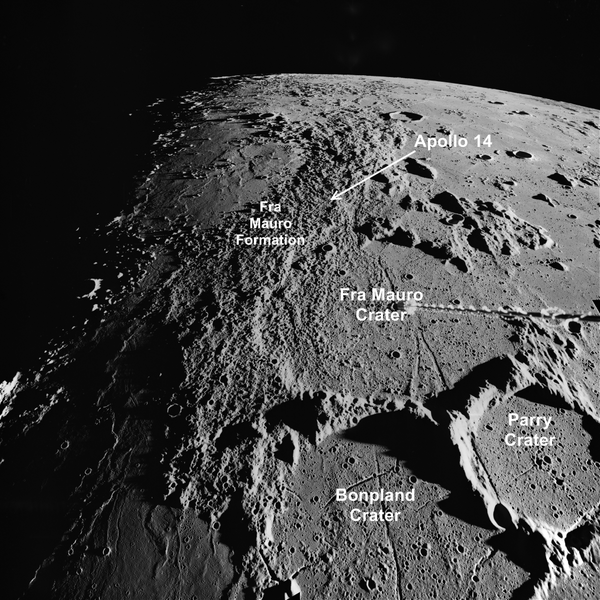
L’analisi dei campioni di questa zona, una volta analizzati sulla Terra, avrebbe chiarito un importante aspetto nella creazione del Sistema Solare confermando l’età di formazione del Mare Imbrium e aiutato a stabilire età, natura chimica/fisica dei materiali pre-impatto interni alla Luna.
La regione Fra Mauro prende il nome dal monaco italiano divenuto famoso nel 1457 per aver mappato il Mar Mediterraneo con sorprendente accuratezza.
Vicino al sito di allunaggio era inoltre presente una struttura più giovane, conosciuta come Cone Crater (diametro 305m, profondo 76m) che fu oggetto della seconda passeggiata esplorativa (EVA2).
Obiettivi principali della Missione:
- Eseguire un’accurata analisi selenologica completa di campionature, per le formazioni presenti nella regione prescelta Fra Mauro
- Installare ed avviare il pacchetto di esperimenti previsti dal ALSEP (Apollo lunar surface experiment package)
- Dimostrare come siano possibili le attività lavorative umane nell’ambiente lunare.
- Fotografare, ad alta risoluzione, possibili nuovi siti per future missioni esplorative.
- Fotografia di fenomeni nello spazio profondo del tipo luce zodiacale e gegenschein
- Test di comunicazione usando le frequenze S-band e VHF al fine di determinare le proprietà riflettenti della superficie lunare.
Sebbene gli obiettivi primari fossero gli stessi di quelli previsti per la missione Apollo 13, i risultati attesi furono più ambizioni in termini di una maggiore quantità di campioni di roccia lunare da riportare a Terra, unitamente ad una più estesa raccolta di dati scientifici. Per aumentare l’efficacia delle esplorazioni alleviando, al contempo, il carico di lavoro per i due astronauti, fu previsto un carrellino estensibile a due ruote, il Modular equipment transporter (MET) per trasportare attrezzi, telecamere, il magnetometro portatile e i campioni lunari. L’utilizzo del rickshaw fu definito “adeguato” da parte degli astronauti, tuttavia si è compreso che non fosse per niente facile tirarselo stabilmente in salita con le due ruotine che sprofondavano nella polvere. Nella successiva missione Apollo 15 il carrellino verrà sostituito dal più performante rover motorizzato.

L’esperimento Gegenschein
Particolarmente interessante dal punto di vista astronomico fu l’esperimento denominato Gegenschein. Il G. è un fenomeno celeste che appartiene al genere “luce zodiacale” ed è conosciuto da oltre 150 anni come una fonte di luce debolissima, visibile sotto condizioni favorevoli nel cielo notturno, vicino al punto antisolare. Questo fenomeno può essere erroneamente scambiato per una nube del tipo cirrostrato. In condizione di visibilità ottimali, il fenomeno del gegenschein appare approssimativamente di 10° in diametro, ma se la porzione di cielo è luminosa, allora la zona interessa un diametro minore fino a scomparire del tutto se la luna è presente oppure la via Lattea è visibile. L’unico aspetto che si ritiene di conoscere è la causa dovuta alla riflessione della luce solare incidente i granelli di polvere dispersi nello spazio.
Tuttavia rimane un mistero dove questo fenomeno abbia precisamente origine. Verso la fine del XIX secolo, Carl Moulton e H. Gylden teorizzarono che la polvere potesse accumularsi in uno dei punti Lagrangiani L1 del sistema Sole-Terra.

Questa teoria fu largamente accettata per la prima metà del XX secolo, sebbene successivamente alcuni scienziati hanno cominciato ad avanzare dubbi che questo esperimento vuole aiutare a chiarire.
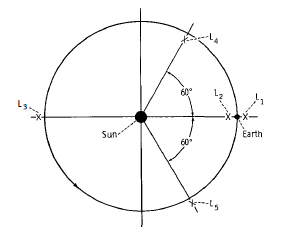
I punti di librazione furono scoperti dal matematico francese Lagrange. Essi rappresentano i punti di equilibrio in un sistema gravitazionale a tre-corpi, dove la risultante le due forze gravitazionali, causate dal primo e secondo corpo in orbita, viene bilanciata dalla forza centrifuga derivante dalla rotazione del sistema. Il sistema Sole-Terra ammette 5 punti le cui cooordinate sono fisse in un sistema con centro il sole e sincrono con la rotazione della Terra. Il punto L1, dove l’eccesso di forza centrifuga è controbilanciato dalla maggiore gravità terrestre, giace a circa 1,5 milioni di km dalla terra. Ragionamenti simili determinano gli altri punti di equilibrio.
Una differente ipotesi del gegenschein ne attribuisce la causa ad una intensificazione della luce zodiacale nella direzione antisolare dovuta alle proprietà di diffusione ottica (scattering ) delle polvere interplanetaria attraversate dalla luce solare. In questo caso la zona di origine forse è collocata nella cintura degli asteroidi fra Marte e Giove. Siccome l’orbita della Luna è situata a circa 380,000km dall’asse Sole-Terra, le osservazioni del fenomeno di Gegenschein dall’orbita lunare permettono una triangolazione che avrebbe risolto quale delle due ipotesi fosse corretta. L’esperimento è reso difficile dalla bassa luminosità del fenomeno, ma se ripreso dal modulo di comando in orbita lunare dell’Apollo 14 avrebbe avuto a disposizione il doppio vantaggio di attraversare per 25 minuti, ogni 2 ore circa, una delle zone d’ombra accessibili agli uomini più scure in assoluto, evitando l’effetto di diffusione prodotto dall’atmosfera terrestre.
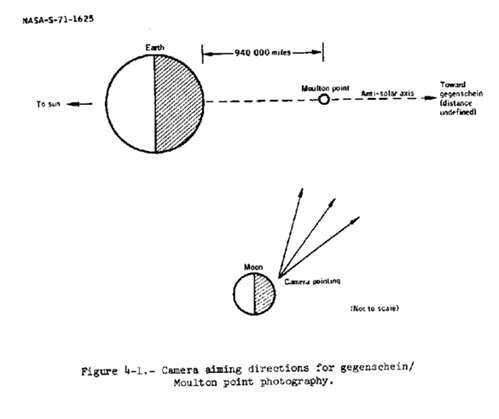
Sebbene le fotografie e i filmati dal CM nel corso dell’orbita n.16 furono eccellenti per qualità di ripresa, la successiva analisi fotometrica con microdensitrometro, non permise di rilevare con sufficiente chiarezza la zona di origine del fenomeno in modo da determinare l’angolo di parallasse. L’unico risultato positivo per questa missione fu che esposizioni più lunghe di 20 secondi erano possibili senza significativa perdita di messa a fuoco per le stelle fisse. Ogni eventuale risposta conclusiva venne ancora una volta rimandata alla successiva missione Apollo, ponendo forse fine ad una ricerca iniziata con il progetto Mercury nel 1963 e proseguita poi con alcune missioni del progetto Gemini fino al 1966, senza contare i numerosi esperimenti condotti dal NASA Goddard Space Flight Center tramite razzi, palloni stratosferici e altri satelliti artificiali.
[1]
Principali criticità:
L’investigazione delle cause che avevano portato l’Apollo 13 vicina al disastro, conseguente alla rottura del serbatoio criogenico di ossigeno, aveva condotto alla riprogettazione dell’apparato con tre significativi cambiamenti nel CSM cryogenic oxygen storage and electrical power system incorporato nell’ Apollo 14 e nei veicoli successivi:
1) costruzione interna del serbatoio modificata, 2) aggiunta di un terzo serbatoio e 3) installazione di una batteria ausiliaria.
Le tre modifiche operarono in maniera positiva, senza più alcun problema.
I tre astronauti incorsero però in un primo problema mentre si prepararono a lasciare l’orbita terrestre. Una delle attività richieste era quella di agganciare il modulo di comando Kitty Hawk con il lander lunare Antares ancora attaccato al terzo stadio del booster e dirigere i due velivoli verso la Luna. Tuttavia i tre ganci di attracco non ne vollero sapere di funzionare e dopo 5 ripetuti tentativi falliti, il controllo di missione ordinò al pilota del modulo di comando Stuart Roosa, di azionare i motori di spinta del CSM in modo da esercitare una pressione fra i due moduli mentre il comandante Shepard agiva manualmente su uno dei due sistemi. Questa volta i ganci scattarono correttamente. Verifiche ulteriori, sia a bordo che sul simulatore a terra, confermarono che l’apparato non presentava problemi e che pertanto la missione poteva proseguire essendo l’inconveniente causato probabilmente dal fatto che nei tentativi precedenti il sistema di aggancio non si trovasse nella esatta posizione attesa di blocco.
Un secondo problema occorse in fase di allunaggio dopo la separazione fra i moduli e prima dell’accensione dei razzi di discesa per la PDI (powered descend initiation).
I tecnici del centro di Houston nel controllare la memoria del computer di bordo (LGC — LM Guidance Computer) individuarono che un singolo bit di memoria era impostato in maniera non corretta. Il bit LETABORT indicava lo stato aperto o chiuso del pulsante di abort. Il guasto fu isolato in un cortocircuito dell’interruttore forse dovuto ad una particella libera di saldatura che chiudeva in maniera random il circuito elettrico. Mitchell fu in grado di resettare l’interruttore dandogli dei piccoli tocchi ma dopo un po’ il segnale di chiusura si ripeteva. Una procedura software (patch) alternativa fu sviluppata dai tecnici MIT per ignorare l’inconveniente, mentre i razzi di discesa venivano accesi per 764,61 sec del 5 febbraio 1971, quando le due navicelle si trovavano 50.000piedi sopra la Luna ed erano trascorse 108:02:29 ore dal momento lancio (GET — ground elapsed time).
Circa 6 minuti dopo l’inizio delle operazioni e giunti ad una altitudine di circa 32,000 piedi, Il pilota del LM Antares, Ed Mitchell scoprì che il radar di discesa non si era ancora “agganciato” alla superficie lunare, e una volta raggiunta la quota critica di 10,000 piedi questa anomalia avrebbe impedito di calcolare correttamente la distanza dal suolo e, secondo gli standard NASA avrebbe fatto abortire la fase di allunaggio. Il controllo di terra suggerì di ciclare manualmente l’interruttore del circuito on-off per resettare il sistema, consentendo a Shepard di ripristinare il corretto funzionamento del radar e permettendo alla missione di continuare. Più tardi fu scoperto che l’anomalia era diretta conseguenza della precedente patch al firmware di bordo. Il LM radar di discesa ha due modi operativi, quello di lungo raggio per quando il modulo si trova ad una altezza di 32–36,000 piedi e un modo a corto raggio per le operazioni sotto i 12,000. La modifica apportate al software prima della fase di discesa PDI, aveva inavvertitamente impostato il radar sulla secondo modalità di misurazione e questo aveva reso impossibile ottenere un impulso valido che si potesse riflettere quando l’altitudine orbitale era elevata. Il reset del circuito aveva permesso al sistema radar di re-boot nello stato di default, che corrispondeva al lungo raggio. Questo intervento ha salvato in definitiva la missione.
L’esperienza combinata di questi eventi imprevisti, porta ad immaginare che sarebbe stato impossibile il successo di una missione così complessa, senza la presenza fisica di astronauti a bordo. La capacità dei diagnosticare i problemi, prendendo le appropriate azioni in tempo reale, richiede un intervento da parte dell’uomo che, è stato fatto notare, sarebbe difficile o impossibile da ottenere esclusivamente tramite sistemi automatici. Non per sminuire il contributo dei sistemi robotici che hanno consentito grandi risparmi, ma almeno in questo caso, avere degli astronauti pronti all’uso ha certamente rappresentato un vantaggio
[2], [3]
Luna!
Il 5 febbraio 1971 Antares posò completamente i pads di allunaggio alle 09:18:13 GMT (04:18:13 a.m. EST). Il tempo trascorso a terra dal lancio era in quell’istante GET 108:15:11.4
Il LM aveva raggiunto le colline Fra Mauro con la maggiore precisione di sempre a meno di 54metri di distanza dall’obiettivo previsto e a 204 km dal punto di sbarco dell’Apollo 12
Quello stesso giorno, Alan Shepard divenne l’unico astronauta del programma Mercury a toccare il suolo lunare; per giunta alla ragguardevole età di 47 anni. Il CAPCOM Bruce McCandless fece garbatamente osservare questa singolarità mentre guardava sul suo monitor Shepard scendere la scaletta del LM :
113:50:52 McCandless: Roger. (Long Pause) Okay, Al. Beautiful! We can see you coming down the ladder right now. It looks like you’re about on the bottom step. (Pause) And on the surface. Not bad for an old man.”
Il comandante Shepard gli rispose ricambiandolo con altrettanta spontaneità :
113:51:26 Shepard: Okay, you’re right. (referring to himself in the third person) Al is on the surface. And it’s been a long way, but we’re here”.
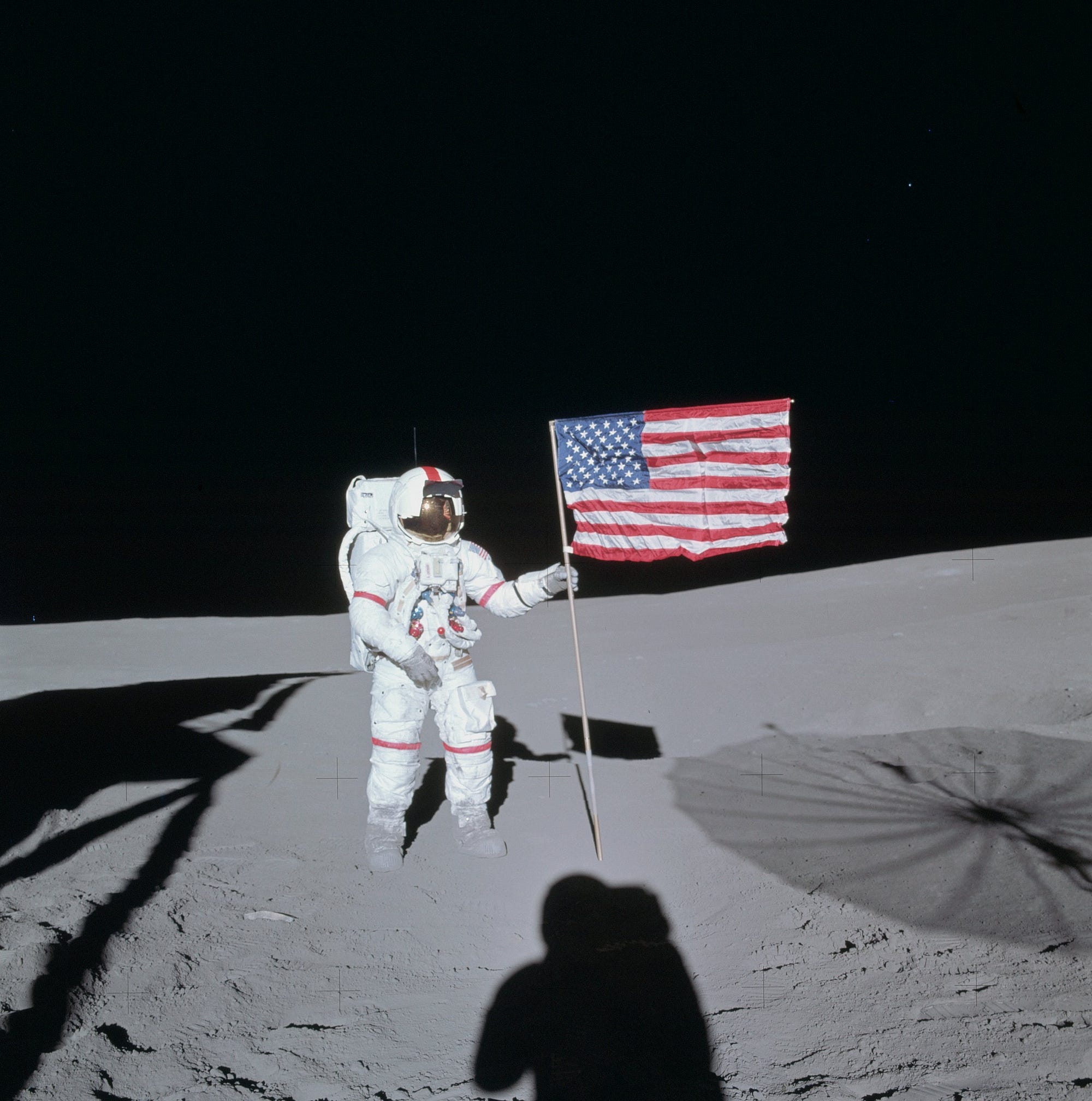
Durante le 33.5 ore trascorse sulla Luna i due astronauti effettuarono due uscite (EVA) per un totale di 9 ore e 24 minuti di attività extraveicolare.
Queste EVAs coprirono un percorso di circa 3.5km, permettendo di raccogliere 42.28kg di campioni lunari da 13 siti diversi ed effettuare una decina di esperimenti scientifici.
Le rocce lunari erano in prevalenza aggregati (breccias) frutto delle complesse trasformazioni dinamiche succedutesi nel corso di miliardi di anni e dei numerosi impatti ripetuti dovuti a micrometeoriti.
Il modulo di comando Kitty Hawk ammarò felicemente al largo delle isole Samoa alle 4:05 PM EST del 9 Febbraio 1971, esattamente 9 giorni e due minuti dopo il lancio.

Le foto dell’archivio NASA:
la foto seguente, relativa alla missione Apollo 14, fa parte di una serie di foto che possiedo dal 1976 proveniente direttamente dall’archivio NASA e ha per titolo LUNAR PHOTOGRAPHY
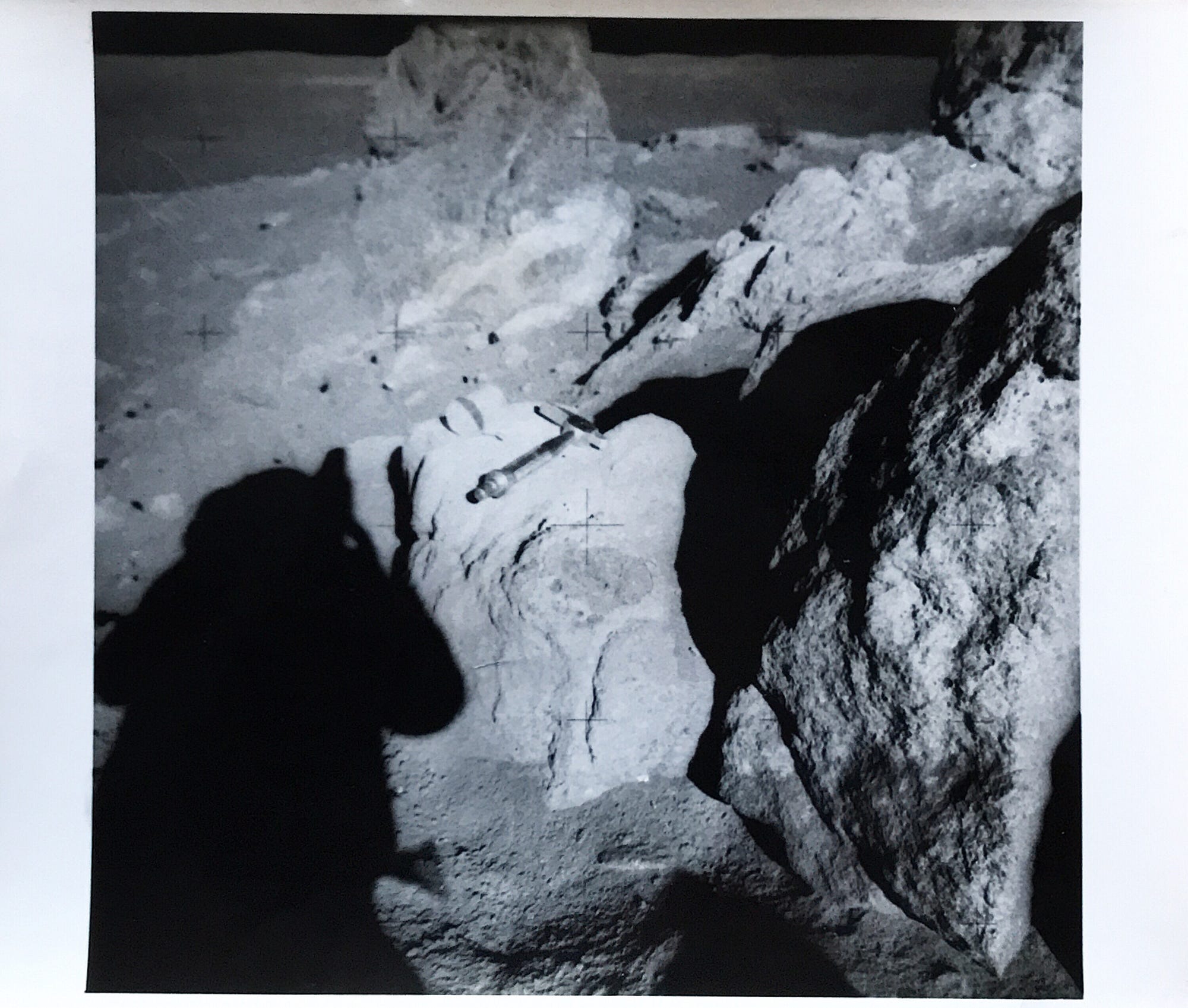
NASA al numero di catalogo 71 -662 (AS14–68–9453)
Il testo sul retro della fotografia in formato originale 7”x9” su carta Kodak, descrive un ammasso roccioso situato sulle colline della regione Fra Mauro. Nella foto è visibile, oltre all’ombra dell’astronauta Ed Mitchell (come risulterà dal log), il martello da geologo, approssimativamente lungo 35 cm e un contenitore per la raccolta dei campioni (Dixie-Cup). La foto in oggetto è significativa perché testimonia la roccia osservata dai due astronauti al punto di raccolta C1 nei pressi del bordo sud del cratere Cone e denominata “Saddle Rock” anche chiamata “White rock” per via di alcune striature bianche in corrispondenza della fenditura centrale.
Questa foto fu scattata il 5 Febbraio nella seconda missione extraveicolare, corrisponde al GET 133:42:31 dal momento del lancio.
Il log originale relativo a questa fase appartenente alla EVA2 è il seguente
[4], [5]:

133:35:32 Haise: And, Al. Did you say you had taken a sample of the white boulder or was that too large to sample?
[Al and Ed have a geology hammer they can use to chip samples off of boulders but, as yet, have not used it. Ed will chip some samples off Saddle Rock but, compared with the later crews, they will use it sparingly. As is demonstrated by the relative ease with which geologist Jack Schmitt could chip sizable samples — and the somewhat greater difficulty that Gene Cernan had — experience helps.]
133:35:48 Shepard: No. Right now I’m sampling a layer that is sort of a light gray just under the regolith. That went in bag number 9; and bag number 10 was a sample of some of the surface rocks that were right around that area. It looks like kind of a secondary impact that has disrupted the surface regolith and gone on down into the gray area.
133:36:16 Haise: Roger, Al.
[The NASA Public Affairs commentator reports that Al’s heart rate is 108 and Ed’s is 86. Al has been working harder, digging a shallow trench to expose the light-colored layer. Figure 10–5 in the Apollo 14 Mission Report shows the crew’s heart rates during EVA-2. Al took three photos of this sampling site: AS14–64- 9125 to 9127.]
133:36:18 Shepard: Okay. You want to…
133:36:21 Mitchell: Oh, we’ll make a grab sample here as well as documenting. (Garbled). (Pause)
133:36:43 Haise: Okay. And, Ed, is the LPM still in your immediate area?
133:36:52 Mitchell: Yeah.
133:36:53 Haise: Okay. They wanted a temperature reading off of it.
133:37:02 Shepard: Okay, he’ll get it for you in a minute.
133:37:04 Mitchell: I’ll get it (Pause) (Garbled). (Pause)
133:37:23 Haise: Okay. And, Al…
133:37:25 Shepard: Do you want the gnomon?
133:37:26 Haise: …did you mention either seeing a white boulder or a brownish gray boulder earlier?
133:37:39 Shepard: I mentioned there’s a boulder definitely whitish in color, Fred. We’ll be over there in a minute. Not in our immediate vicinity. But it definitely looks worthwhile sampling.
133:37:50 Haise: That’s affirm…
133:37:51 Mitchell: Fred, the (garbled under Haise).
133:37:52 Haise: …They concur here and would like a sample from the white boulder. Go ahead, Ed.
133:37:58 Mitchell: 125 (degrees Fahrenheit or 52 Celsius) on the LPM.
133:38:01 Haise: Roger, copy.
[Ed has just looked at a patch called a tempa-label on the LPM. It has a series of spots which change from white to black successively higher temperatures. A detail from Apollo 13 training photo 70-H-103 (scan by Frederic Artner) shows a tempa-label on the handle of a fuel-transfer tool.]
133:38:10 Mitchell: Okay. Where is it you’re headed for, Al?
133:38:13 Shepard: Well…
133:38:14 Mitchell: I’ll get the bag.
133:38:15 Shepard: …the first thing that we ought to do, if we want to drag the MET with us…See that white boulder down there?
133:38:23 Mitchell: Yeah. I saw it. Let’s grab a…
133:38:26 Shepard: We can sample both types of boulders right down in that area, so let’s go on down there.
133:38:31 Mitchell: Right.
[The white boulder is at station C1, their closest approach to the rim. The white boulder is now known as Saddle Rock and is visible on the traverse map at CY.6/89.0. It is labelled 1107 on the USGS map. See, also, a detail ( 0.5 Mb ) from the 28 November 2009, 0.5m/pixel LRO image.]
[Mitchell — “The elevation at C1 is lower than C-Prime. C-Prime is on a ridge. Remember, Al was headed for a ridge that he thought was the rim. We got to that and it was an elevation, it was this (‘east’) ridge that runs off the south flank of Cone Crater. The only problem is, it was on the south, not on the west. But it was a higher point. And as you can see on this map, there is this breach in Cone (that, is the southern rim is not raised). It’s not a well-defined rim, right here on the south edge. So C-Prime was sloping down and that was relatively level terrain right in there on the approach to the rim. And C-Prime was a higher point than C1. Yet we still could not see into the crater. After the fact, that was the only thing we missed (out of their pre-mission goals) — the actual view into it. Otherwise, we were right there.”]
[An added problem in finding Cone is the fact that the north rim is significantly lower than the south rim, removing another potential visual clue. As can be seen in a detail from the USGS map, the north rim is roughly 40 meters below the south rim near C1.]
133:38:33 Shepard: And can you give us a feel, Houston, about when you’d like us to leave the area?
133:38:41 Haise: Okay. Estimated time of departure is in about 8 minutes, 7 and a half minutes (from now).
133:38:50 Shepard: Okay.
133:38:51 Mitchell: Okay. Want the hammer? I’ll grab it.
133:38:59 Shepard: Okay. I guess we just (pause) run down there this way, huh?
133:39:08 Mitchell: Yeah.
133:39:11 Shepard: Okay.
133:39:15 Mitchell: (Garbled). One of these boulders, Fredo, is broken open. They’re really brown boulders on the outside, and the inner face that’s broken is white, and then another one that most of it is white. They are right in the same area.
133:39:33 Haise: Okay, Ed. I assume you’re going…
133:39:34 Shepard: Okay, I believe that’s probably a…
133:39:34 Haise: …to sample some of those.
133:39:39 Mitchell: That’s where we’re headed right now. It’s about 50 yards (45 m) away.
[According to the Cp-to-C1 traverse map, the distance from position marked “133:39:39” to Saddle Rock is about 60 meters, so Ed’s estimate is reasonably good.]
133:39:45 Shepard: Why don’t you go on down and start, and let me bring the MET down.
133:39:48 Mitchell: All right. Yeah. It’s further than it looked.
133:39:53 Shepard: That’s the order of the day. (Long Pause)
133:40:24 Mitchell: Okay, Fredo. I’m right in the midst of a whole pile of very large boulders here. Let’s see what I can do to grab a meaningful sample.
133:40:40 Haise: Roger, Ed.
133:40:48 Mitchell: First of all, let me start by photographing (pause) this whole area. (Long Pause) They (meaning the boulders)’re all so darn big that there’s hardly anything that I can find (that’s small enough to put in a sample bag) Let’s see if I can chip one. (Pause)
[Mitchell — “There’s no small rocks here. They are all really big boulders. Volkswagen-sized boulders.”]
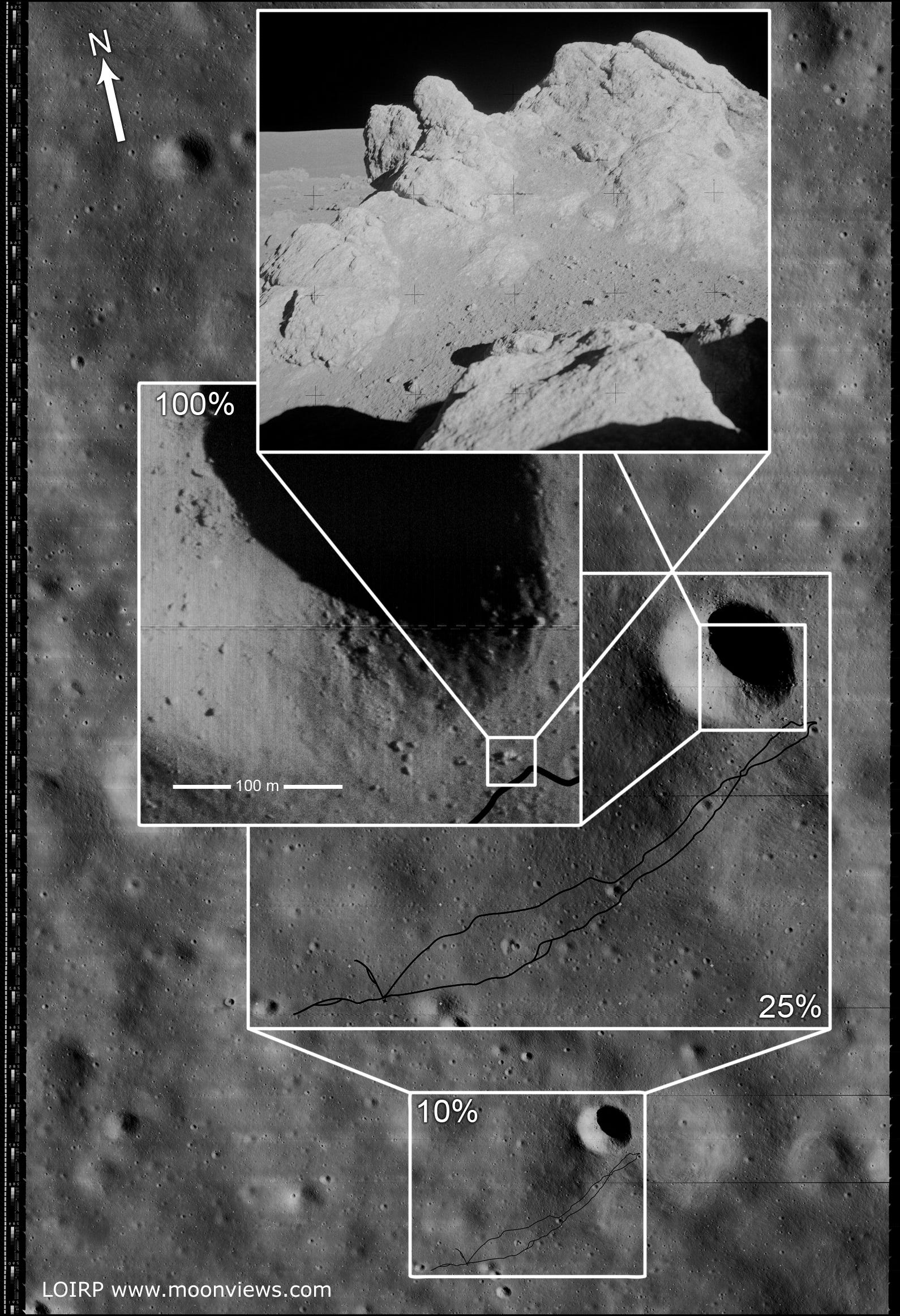
133:40:48 Ed has turned further to his right to take this portrait of the boulder known as Saddle Rock. Note the extensive skirt (fillet) of dirt that has built up at the base of the rock. There is even dirt that has been thrown up onto the sides of Saddle Rock, presumably from an impact somewhere in the area. Keith Cowing of the Lunar Orbiter Image Recovery Project has put Saddle Rock in the context ( 2.2Mb ) of restored Lunar Orbiter frame 133-H2.
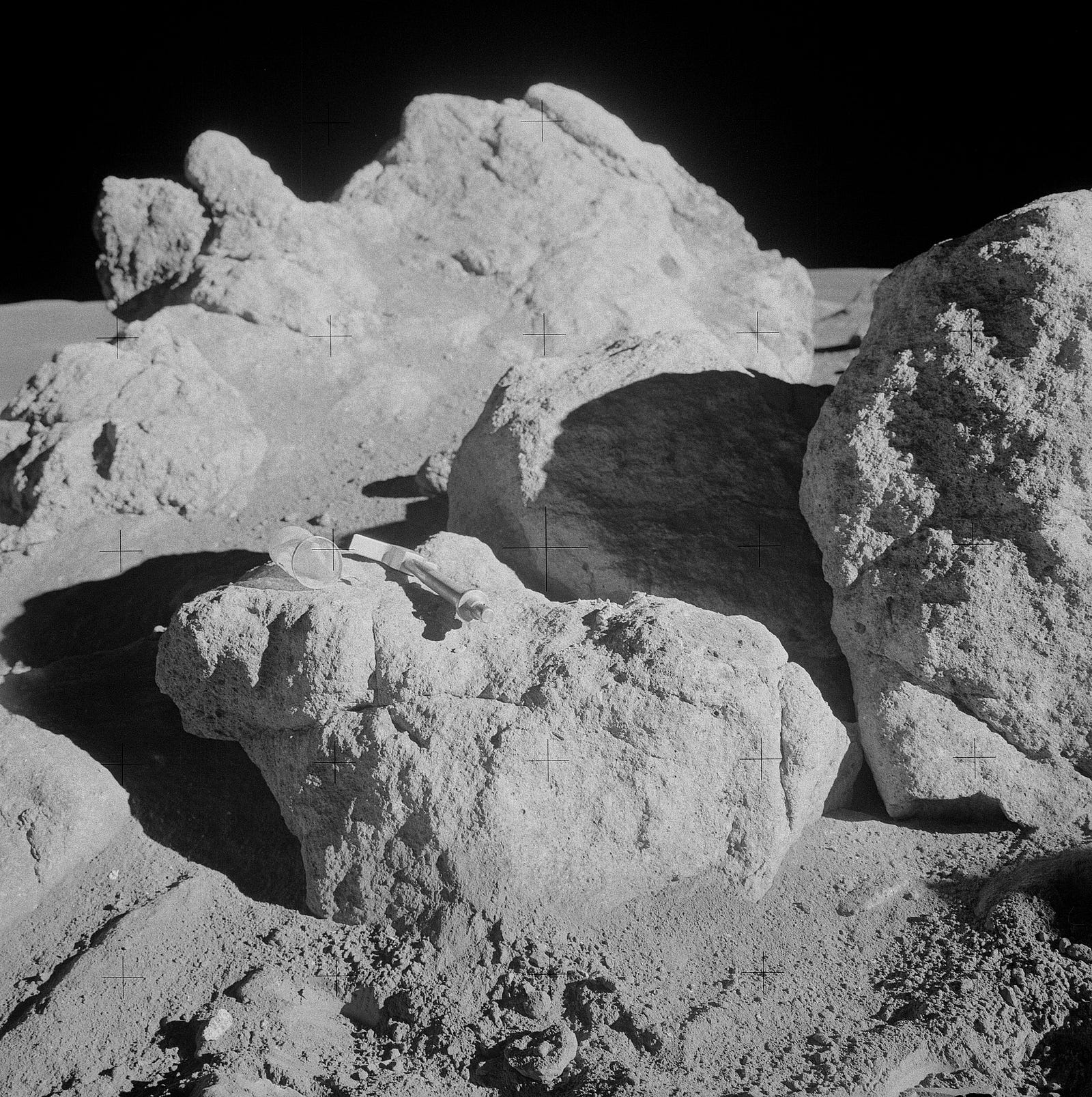
133:40:48 Down-Sun of the southern face of Saddle Rock. Notice that he has put his hammer and one of the “Dixie-Cup” sample bags on the smaller white boulder in the foreground. In the Apollo 14 Preliminary Science Report, this boulder is referred to as White Rock. The tall boulder above and beyond the hammer is the same one shown in 9449
Frame 9448 is a close-up of the white boulder. The LM is just above the righthand corner of the boulder, as indicated in a detail.
In 9452, we can see one of the “Dixie cup” sample bags lying next to the hammer on the rock. The bag has a circular opening about 13 cm across and is 26 cm long.
In the background of 9452, the large boulder with the knob on the left side is Saddle Rock, which is labeled ‘1107’ on the USGS map.
133:41:52 Haise: Okay, Ed and Al.
133:41:53 Mitchell: Okay, Fredo, I…(Listens)
133:41:57 Haise: To get…
133:41:58 Mitchell: Go ahead.
133:41:59 Haise: To get us back on the old timeline here, when you depart C here, we’d like to proceed directly to (Station) F, Weird (Crater) (at about CR/73 on the traverse map). And we’ll pick back up from that point. En route you can make grab samples as you see fit.
133:42:20 Shepard: Okay.
133:42:22 Haise: And another note I’ll remind you of…
133:42:24 Mitchell: Hey, Fredo; I’ve chipped some…
133:42:25 Haise: …later on. Go ahead. I’m sorry.
133:42:31 Mitchell: I’ve chipped off one of the white rocks. I put it in bag 13-N. I’ll photograph it. There don’t seem to be any samples of the white rocks lying around that are small enough for me to sample and be sure they’re what I’m looking for.
133:42:52 Haise: Roger, Ed. 13-N. (Long Pause)
[Ed’s “after”photo of his chip sample at Saddle Rock is AS14–68- 9453.]
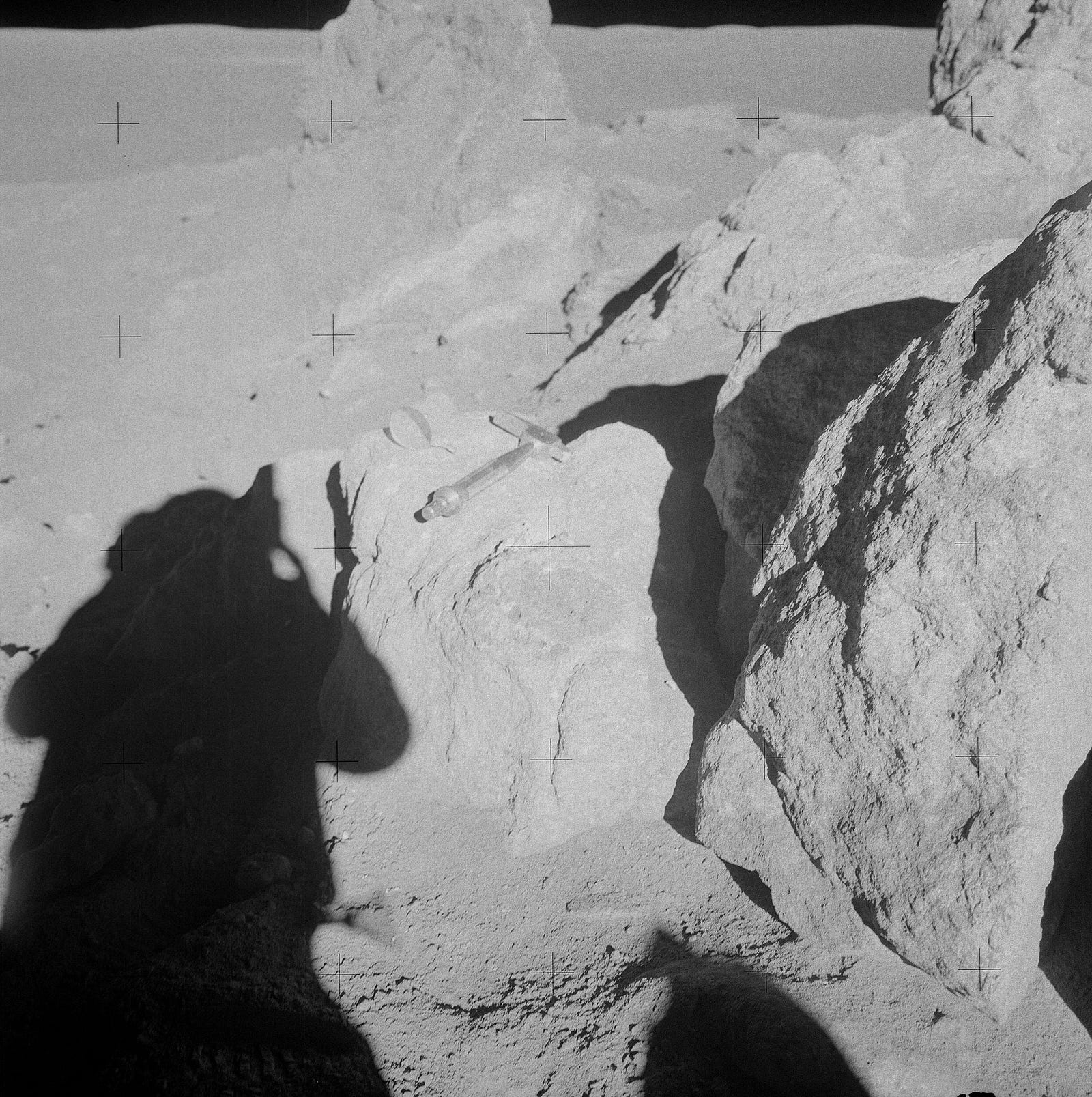
133:42:31 Ed has chipped a sample off White Rock and then took this “after”. The chip was taken off the rock just below and to the right of the end of the shadow of the hammer handle
133:43:12 Shepard: And Al is just going around picking up hand-size grab samples (possibly with the tongs) from the immediate vicinity of where Ed is operating. I have a couple that are going in bag 16.
133:43:30 Haise: Roger, Al. (Long Pause)
133:44:29 Mitchell: (Garbled) help with that one?
133:44:30 Shepard: That’s all right, I think I got it. There’s a football-size rock, Houston, coming out of this area, which will not be bagged. It appears to be the prevalent rock of the boulders of the area. Got it?
133:44:41 Mitchell: Got it.
133:44:55 Haise: Roger, Al, we copy.
133:44:56 Mitchell: Have to go in one of the Z-bags.
133:45:00 Shepard: Okay. Do you have a sample of that white rock?
133:45:03 Mitchell: Yeah, I got one batch of particles.
133:45:06 Shepard: Put it (that large rock) right in here.
133:45:09 Mitchell: I don’t think it’ll go.
133:45:10 Shepard: Yeah. Core tube’s out of the way. Put her down.
133:45:22 Shepard: Okay. We’ll just carry it back that way.
133:45:24 Haise: Okay, Al and Ed. We have…
133:45:26 Mitchell: (Garbled under Haise).
133:45:26 Haise: …about 1 more minute here at C.
133:45:33 Shepard: Okay. We’re moving on down the hill now. (To Ed) Okay; can you see Weird from here?
Riferimenti :
[1] NASA SP-272 Apollo 14 Preliminary Science Report
In spite of not reaching the crater rim, the samples retrieved by the Apollo 14 crew yielded a rich geologic harvest…www.freerepublic.com[3] APOLLO 14 — NASA Summary
Although the primary mission objectives for Apollo 14 were the same as those of Apollo 13, provisions were made for…history.nasa.gov[4] Apollo 14 Image Library
This Apollo 14 Image Library contains all of the pictures taken on the lunar surface by the astronauts together with…www.history.nasa.gov[5] Apollo 14 — Lunar Surface Journal — Geology at Cone Crater
Shepard, from the 1971 Technical Debrief — “We stopped and started taking samples. I feel pretty sure that we have some…www.history.nasa.gov